Today we are going to talk about can a Belgian Malinois be all black. A Black Belgian Malinois would make a wonderful companion if you’re looking for an elegant black dog.
Here are some basics for those who are unfamiliar with the breed. There are several varieties of Belgian Shepherds, but the Malinois is one of them. Black and tan are the most common colors.
As well as red sable, fawn sable, gray and other colors, other colors are available as well. The black Belgian Malinois will be the focus of this article. In no way should you consider this dog as a separate breed.
Despite the fact that black Belgian Malinois exist, they are extremely rare. Despite their solid black coats, Malinois does not have the distinctive black masking that made them distinctive in the past.
Only a few breeders produce black Belgian Malinois because not all kennel clubs recognize it as a standard color.
In other countries, the Belgian Malinois is one of four varieties of the Belgian Shepherd Dog, which is recognized as a separate breed in the United States.
You will also like: Fun Belgian Malinois Facts and How Much Does A Belgian Malinois Cost?
Table of Contents
Breed History
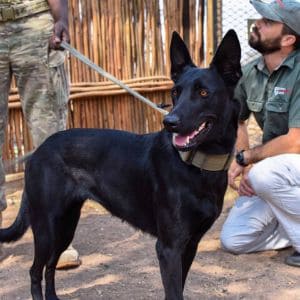
The breed traces its roots to the Belgian region of “Noord-Brabant”. Historically, they date back to at least the 18th century. Their main function was to guard and herd livestock.
All three breeds share the same origin, the Belgian Tervuren, the Malinois, and the Belgian Sheepdog. In Malines, where the Malinois gets its name, the breed was developed mainly.
The Belgian shepherd dog’s short-haired version first appeared in 1899 near Malines. Belgian Shepherds were officially recognized as four varieties in 1901.
Laekenois and Tervueren, as well as the pure-black Groenendael, are all members of the Belgian shepherd breed. Since then, Mali has become the most popular service dog and the best-known Belgian shepherd.
The AKC registration of Malinois and other Belgian Shepherd Dogs skyrocketed after World War I, when soldiers returned from Europe with these dogs.
An American Kennel Club (AKC) member club, the Belgian Sheepdog Club of America, was established in 1924.
It has been a decade since Belgian Malinois dogs have been highlighted for their work in the military, law enforcement, and police departments across the country. The United States has imported a large number of Malinois since then.
What Makes Them Black?
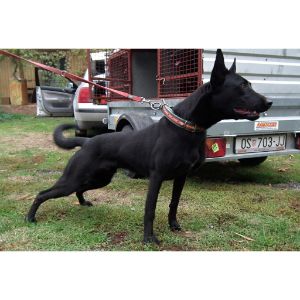
Eumelanin (black) and pheomelanin (red) are responsible for canine coat colors and patterns. Other genes contribute to color and pattern differences.
We know that Mals produce eumelanin because they have a black mask. What are the reasons why there are not as many solid black Belgian Malinois as other colors? Here’s what determines the color,
A Locus
Pigment distribution in a dog’s coat is controlled by the Agouti gene (A locus). Fawn or sable base coats with a black overlay are produced by the Ay (yellow) allele in this gene.
Belgian Malinois are dominant on this allele, so only one Ay is required for this color. The solid black coat can also be caused by the allele a (recessive black). Having a black coat requires a mal to be recessive.
Studies have shown that Malinois usually carry the black recessive allele, but not always. Due to the rarity of this allele in Mals, finding two dogs carrying it is even more challenging.
K locus
Known as the ‘dominant black locus’, the K locus is found in the male genome. A solid black coat is produced by the dominant allele Kb. The Kb gene is epistatic to the A locus, so it overrides the effects of the genes in the A locus.
In the absence of the recessive allele ky, the A locus will not be affected. Belgian Sheepdogs, or Groenendaels, are black since they are mostly KbKbor Kbky.
However, Mals must receive the recessive black allele (a) from both their parents in order to be black.
E locus
The E locus has the dominant allele Em. This resultant mask can be found on the muzzle, the chest, the back, and the tail. Belgian Malinois masking is caused by this allele.
Belgian Shepherd varieties have a variety of coat colors and types due to dominant genes in their lines. Belgian Malinois have a dominant gene that produces the standard fawn or sable coloration with black masking.
Black Belgian Malinois may appear only as “surprises” in litters where there are already black Belgian Malinois in the breeding line.
Do Kennel Clubs Recognize the Black Belgian Malinois?
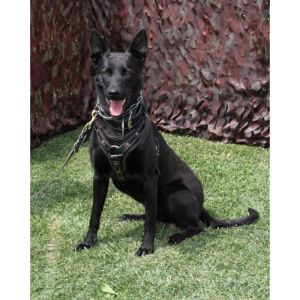
Belgian Malinois are not required to be black, but the AKC recognizes black as a color for Belgian Malinois.
There are a number of other kennel clubs, such as The Kennel Club (UK), The United Kennel Club (UKC), and the Fédération Cynologique Internationale (FCI), which exclude black from their lists of acceptable colors.
Groenendaels are the only breeds allowed to be black in the kennel clubs mentioned. Fawn or mahogany shades are the only colors allowed for Malinois with black masking.
There is a distinction between Belgian Malinois and Belgian Shepherd Dogs in the kennel clubs mentioned above.
More Information About Black Belgian Malinois?
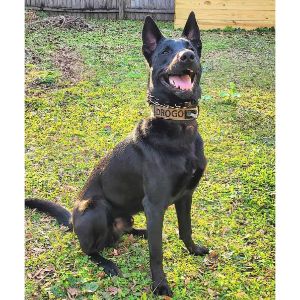
As a dog grows, its coat changes. Double-coated breeds are particularly prone to this. Undercoats of Belgian Malinois are dense, and topcoats are short and harsh.
The coat color of Belgian Malinois that are standard-colored may change a bit as they grow. The change might not be apparent in black Belgian Malinois, since they already have dark coats.
Health Problems
The hip socket is not developed properly in hip dysplasia. Large dog breeds tend to suffer from hip dysplasia, but Malinois can also suffer from it. Symptoms include discomfort, pain, and muscle atrophy. Over time, it may also lead to arthritis.
Elbow dysplasia is a developmental abnormality that causes elbow dysplasia. Lameness and elbow pain may result from these abnormalities.
Nutritional factors, genetic factors, and developmental factors can all contribute to the problem. It may take between four and 18 months for dogs to be diagnosed with this disease.
A Belgian Malinois is at risk of developing Progressive Retinal Atrophy (PRA). Genetically, retinal degeneration leads to blindness. Mal does not feel pain when they have PRA, but it cannot be cured either.
Sensitivity to anesthesia is said to be a characteristic of Belgian breeds. Acepromazine has been reported to be hypersensitive to some dogs in a brochure produced by the Belgian Sheepdog Club of America (BSCA).
During the postoperative period, some dogs were unable to stand after receiving a tiny dose of the medication. If the procedure requires anesthesia, be sure to speak with your veterinarian.
Temperament
There are many qualities that make this breed ideal for working dogs. Their intelligence and power are unsurpassed. A Malis makes a great service dog for a good reason.
Their power and reliability make them excellent guard dogs. However, they will never act aggressively without reason. In order to protect you, they have a fearless personality.
You will always get their full commitment from them because they are full of energy. In this breed, you will find a fearless and lively dog that is also friendly and sweet. Families consider them loyal and affectionate, and they are strongly tied to them.
Other pets and humans enjoy living with the black Belgian Malinois. However, early socialization is necessary for them.
Contrary to appearances, temperaments are not arbitrary. Socialization, genes, and training are all factors that influence it.
In addition to being adventurous and energetic, puppies with a good temperament enjoy being held and interacting with people. You can also determine what the puppy will be like as an adult by meeting its parents, siblings, or other relatives.
If the children are well-socialized with Malinois, especially if they have been raised with them, they are usually good with them, although due to their herding heritage, they may try to herd them at times.
In order to prevent your Malinois from behaving in such a manner, you must teach him not to do so. It is best to place an adult Malinois with children who can interact properly with him in a home with young children who are used to being around them.
Malinois can be violent toward other dogs and cats unless they’ve been raised with them since puppyhood.
To teach your Malinois how to get along with other animals, you must start early and praise good behavior. When your Malinois is not socialized with other animals, you must keep him under control.
Because of their high energy level and sensitivity, Malinois should only be considered by people who have owned dogs in the past and have experience training them.
Regardless of what the family is doing, Malinois want to be involved in it all. Working long hours or traveling frequently without their dogs isn’t ideal for people with these products.
Grooming
Double coats on Belgian Malinois are short and easy to maintain. It won’t take much time for you to care for them since they don’t require much grooming and are odorless and clean.
As a result of their extensive undercoat, they are not hypoallergenic dogs. Their hair will fly everywhere, and they’ll shed a lot. Cleaning up after them will take a lot of time.
In order for these dogs to keep their lovely coats, you must keep them healthy. Make sure they eat nutrient-dense, high-quality dog food. Dogs with high energy levels should be fed food that matches their energy level.
Their nails should be trimmed regularly, and their ears should be kept clean since they can get infected. In case they need dog ear plucking, take them to the vet. As well as brushing their teeth once a week, they should floss as well.
Its short, easy-to-care-for double coat makes it great for beginners. Dogs that are low maintenance and clean and odorless don’t require much grooming, so you won’t have to spend a lot of time caring for them.
The extensive undercoat of these dogs, however, does not make them hypoallergenic. Their hair will fly everywhere, and they’ll shed a lot. After they’ve been cleaned up, you’ll have plenty of work to do.
In order for these dogs to keep their lovely coats, you must keep them healthy. Make sure they eat nutrient-dense, high-quality dog food.
Dogs with high energy levels should be fed food that matches their energy level. Their nails should be trimmed regularly, and their ears should be kept clean since they can get infected.
In case they need dog ear plucking, take them to the vet. You should also brush your children’s teeth at least once a week.
Are Black Malinois More Expensive Than Other Colors?
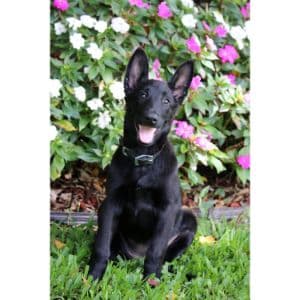
It is generally not easy to find Belgian Malinois puppies at a reasonable price. Depending on your location, they could cost between $1,000 and $3,000.
It is feasible to pay as much as $9,000 for Belgian Malinois puppies from superior lines. It is expected that the price of a black Belgian Malinois will be at the higher end of this range since they are not very common.
In addition to providing basic training for puppies, many breeders also provide adult dog training. The price of their products will increase significantly as a result. The cost of training Malamutes for protection may reach $20,000 or more.
Even military and police dogs can benefit from trained Malinois, which are superior working dogs.
A trained black Malinois might be worth the cost if you want to use it as a personal protection dog. Despite this, socialization and obedience classes might not be necessary if you’re only looking for one as a family member.
You will also like:
- Do Belgian Malinois’ Ears Stand Up?
- Why Do Police Use Belgian Malinois?
- Is A Malinois German Shepherd Mix Right For You?
For more information about the Belgian Malinois Breed, check out the video below:




